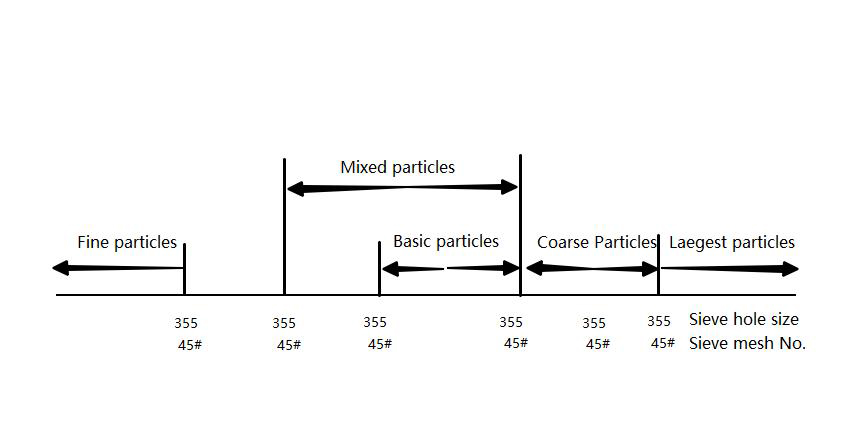Home / News & Blog / Abrasive Blog / What is the Particle Size Composition of Abrasive Grains?
When selecting the right abrasive material for grinding, cutting, or polishing, one of the most critical factors is the particle size composition of abrasive grains. The particle size composition of abrasives influences their performance, efficiency, and suitability for different industrial applications. Understanding the relationship between particle size and abrasive performance can help industries optimize their processes and select the right abrasive grains for their needs.
In this blog, we’ll explore what particle size composition is, how it’s measured, and why it’s important for the selection of abrasives in various industries.
Particle size composition refers to the range and distribution of particle sizes in abrasive grains. Abrasive materials are not made up of particles that all share the same size; rather, they are typically a blend of different size groups, creating a range of particles across multiple mesh sizes or micron ranges.
The particle size distribution of abrasives is essential because it directly influences their cutting, grinding, and polishing capabilities. The performance of an abrasive grain is determined by the specific sizes of the particles and their corresponding ratios.
Abrasive grains are not a uniform group of particles of a single size. Instead, they form a distribution that spans across several sieve sizes. These grains are typically divided into five particle size groups, namely:
Coarse particles: Particles larger than the basic size.
Basic particles: The main size that corresponds to the target screen mesh.
Fine particles: Smaller particles close to the basic size.
Largest particles: Particles that are larger than the coarse group but smaller than the mix group.
Mixed particles: A blend of the basic particles and adjacent finer particles.
For example, let’s take F36 abrasive grains. These abrasive grains are not composed of just one specific particle size. Instead, they are distributed across several particle groups. As shown in Figure 1-2, the grain composition includes coarse particles, basic particles, fine particles, and the mixed particles, each having a designated particle size range.

Example Breakdown of F36 Abrasive Grains:
Coarse particles: Larger than basic grains.
Basic particles: The most common size in F36 and the one typically associated with the sieve screen.
Fine particles: Slightly smaller than basic particles.
Mixed particles: The combination of basic particles and adjacent finer particles.
These particle groups span across several sieve screens, contributing to the abrasive grain’s overall performance.
The particle size composition directly impacts the effectiveness of abrasives in cutting, grinding, and polishing. Here’s how the various groups of abrasive grains affect performance:
Coarse Abrasives: These larger particles are typically used for heavy-duty tasks like material removal, deburring, and rough grinding. They remove material faster but leave a rougher finish.
Basic Abrasives: The main particles in a grain, which are ideal for general grinding and finishing. These provide a balance between cutting efficiency and surface quality.
Fine Abrasives: These smaller particles provide a smoother finish and are used for polishing and precision work. Fine abrasives remove less material but yield better surface quality.
The presence of mixed particles, combining both coarse and fine elements, offers a more versatile abrasive that can be used for applications requiring varying levels of aggressiveness and finish.
In the abrasives industry, particle size is usually measured using the mesh size or micron size. The mesh size refers to the number of holes per inch in a sieve, where higher numbers mean smaller particles. Meanwhile, micron size offers a more precise measurement, where one micron is equal to one-millionth of a meter.
To standardize the measurement of abrasives, national standards specify particle size ranges for different abrasive grades. For example, in China, abrasive grains are classified using both mesh sizes and the F-series (mesh size range) and P-series (micron size range).
F-series: The standard for abrasive grains, such as F36. These sizes are measured in mesh, and F36 would mean 36 openings per inch.
P-series: Used for finer abrasives, measured in microns (e.g., P240 to P2500).
Abrasive particle size standards are further divided into fine powder grades (F230 to F1200), where instruments like the optical sedimentation device and sedimentation tube are used for precise measurements.
The correct particle size composition plays a pivotal role in the performance of abrasives. Here are the reasons why it’s crucial:
Cutting Efficiency: Coarse abrasives provide faster material removal but may not provide the desired finish, while fine abrasives produce a smoother finish but work slower.
Surface Finish Quality: Fine abrasives are required for achieving high-quality finishes on delicate materials. In contrast, coarse abrasives are best for applications that require heavy material removal.
Versatility and Durability: Abrasives with a wide particle size range, such as those containing mixed particles, offer versatility. This combination helps industries adapt abrasives for different phases of manufacturing, from rough grinding to final polishing.
Cost-Effectiveness: Understanding particle size distribution allows manufacturers to select abrasives that balance material removal and surface finish without unnecessary waste of time or resources.
The particle size composition of abrasive grains is essential for determining their performance in various applications. It impacts cutting rate, finish quality, and durability, and should be considered when selecting abrasives for grinding, polishing, or cutting tasks.
By understanding the different particle groups—coarse, basic, fine, largest, and mixed—industries can better choose abrasives that suit their specific needs. Whether for heavy-duty grinding or fine polishing, each abrasive grain’s particle size composition is key to achieving the best possible results.
At DOMILL ABRASIVE, we offer a wide range of high-quality abrasive grains, including brown fused alumina, white fused alumina, and silicon carbide, all with customizable particle sizes to fit your application. With over 20 years of experience in the abrasive industry, we can help you select the right grain for your project.